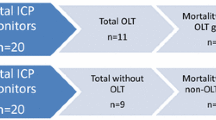Abstract
Background
Measurement of intracranial pressure (ICP) is recommended in comatose acute liver failure (ALF) patients due to risk of rapid global cerebral edema. External ventricular drains (EVD) can be placed to drain cerebrospinal fluid and monitor ICP simultaneously although this remains controversial in the neurosurgical community given the risk of hemorrhagic complications. We describe a patient with ALF and global cerebral edema whose EVD failed immediately before orthotopic liver transplantation (OLT) in which a lumbar drain (LD) was used temporarily to monitor ICP.
Methods
We describe a 36 year old patient with ALF and brain edema from acetaminophen overdose who had an EVD placed for ICP monitoring and management. The EVD failed repeatedly (i.e., lost CSF drainage and ICP waveform) despite several saline irrigations and three doses intraventricular tissue plasminogen activator (1 mg) in the hours that immediately preceded her planned emergency OLT. An LD was placed emergently and controlled cerebrospinal fluid (CSF) drainage and ICP measurement was performed by setting the LD at 20 mmHg and leveling at the ear level (foramen of Monro). The LD was removed once the EVD flow was re-established post-OLT.
Results
The EVD and LD ICP measurements were reported to be the same just prior to removing the LD.
Conclusions
Controlled CSF drainage using a lumbar drain can be used to monitor ICP when leveled at the foramen of Monro if EVD failure occurs perioperatively. The LD can temporarily guide ICP management until the EVD flow can be re-established after OLT.



Similar content being viewed by others
References
Hoofnagle JH, Carithers RL Jr, Shapiro C, Ascher N. Fulminant hepatic failure: summary of a workshop. Hepatology. 1995;21:240–52.
Raschke RA, Curry SC, Rempe S, et al. Results of a protocol for the management of patients with fulminant liver failure. Crit Care Med. 2008;36:2244–8.
Stravitz RT, Kramer AH, Davern T, et al. Intensive care of patients with acute liver failure: recommendations of the U.S. Acute Liver Failure Study Group. Crit Care Med. 2007;35:2498–508.
Fishman R. Cerebrospinal fluid in diseases of the nervous system. 2nd ed. Philadelphia, PA: W.B. Saunders Company; 1992.
Hoekema D, Schmidt RH, Ross I. Lumbar drainage for subarachnoid hemorrhage: technical considerations and safety analysis. Neurocrit Care. 2007;7:3–9.
Levy DI, Rekate HL, Cherny WB, Manwaring K, Moss SD, Baldwin HZ. Controlled lumbar drainage in pediatric head injury. J Neurosurg. 1995;83:453–60.
Hahn M, Murali R, Couldwell WT. Tunneled lumbar drain. Technical note. J Neurosurg. 2002;96:1130–1.
Abadal-Centellas JM, Llompart-Pou JA, Homar-Ramirez J, Perez-Barcena J, Rossello-Ferrer A, Ibanez-Juve J. Neurologic outcome of posttraumatic refractory intracranial hypertension treated with external lumbar drainage. J Trauma. 2007;62:282–6. (discussion 286).
Munch EC, Bauhuf C, Horn P, Roth HR, Schmiedek P, Vajkoczy P. Therapy of malignant intracranial hypertension by controlled lumbar cerebrospinal fluid drainage. Crit Care Med. 2001;29:976–81.
Tomosvari A, Mencser Z, Futo J, Hortobagyi A, Bodosi M, Barzo P. Preliminary experience with controlled lumbar drainage in medically refractory intracranial hypertension. Orv Hetil. 2005;146:159–64.
Willemse RB, Egeler-Peerdeman SM. External lumbar drainage in uncontrollable intracranial pressure in adults with severe head injury: a report of 7 cases. Acta Neurochir Suppl. 1998;71:37–9.
Tuettenberg J, Czabanka M, Horn P, et al. Clinical evaluation of the safety and efficacy of lumbar cerebrospinal fluid drainage for the treatment of refractory increased intracranial pressure. J Neurosurg. 2009;110:1200–8.
Huttner HB, Nagel S, Tognoni E, et al. Intracerebral hemorrhage with severe ventricular involvement: lumbar drainage for communicating hydrocephalus. Stroke. 2007;38:183–7.
Klimo P Jr, Kestle JR, MacDonald JD, Schmidt RH. Marked reduction of cerebral vasospasm with lumbar drainage of cerebrospinal fluid after subarachnoid hemorrhage. J Neurosurg. 2004;100:215–24.
Saito K, Kuwayama A, Yamamoto N, Sugita K. The transsphenoidal removal of nonfunctioning pituitary adenomas with suprasellar extensions: the open sella method and intentionally staged operation. Neurosurgery. 1995;36:668–75. (discussion 675–666).
Coselli JS, Lemaire SA, Koksoy C, Schmittling ZC, Curling PE. Cerebrospinal fluid drainage reduces paraplegia after thoracoabdominal aortic aneurysm repair: results of a randomized clinical trial. J Vasc Surg. 2002;35:631–9.
Blacker DJ, Wijdicks EF, Ramakrishna G. Resolution of severe paraplegia due to aortic dissection after CSF drainage. Neurology. 2003;61:142–3.
Murad A, Ghostine S, Colohan AR. Controlled lumbar drainage in medically refractory increased intracranial pressure. A safe and effective treatment. Acta Neurochir Suppl. 2008;102:89–91.
Poon WS, Ng S, Wai S. CSF antibiotic prophylaxis for neurosurgical patients with ventriculostomy: a randomised study. Acta Neurochir Suppl. 1998;71:146–8.
McCarthy P, Ford C, Shaskikant P, Conrad S, Scott K. Antibiotic use with external ventricular drains and intracranial pressure monitoring devices: A survey of current practices. Abstracts of the Neurocritical Care Society 7th Annual Meeting November 11–14, 2009 New Orleans, Louisiana, USA. Neurocrit Care. 2009;11(Suppl 1):S149.
Author information
Authors and Affiliations
Corresponding author
Rights and permissions
About this article
Cite this article
Bacani, C.J., Freeman, W.D., Di Trapani, R.A. et al. Emergent, Controlled Lumbar Drainage for Intracranial Pressure Monitoring During Orthotopic Liver Transplantation. Neurocrit Care 14, 447–452 (2011). https://doi.org/10.1007/s12028-011-9514-y
Published:
Issue Date:
DOI: https://doi.org/10.1007/s12028-011-9514-y




